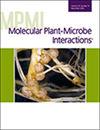求助PDF
{"title":"Transcriptome and Cell Type Signature Analysis of Laser-Microdissected Syncytia Induced by the Cyst Nematode <i>Heterodera schachtii</i> in <i>Arabidopsis</i> Roots.","authors":"Xunliang Liu, Melissa G Mitchum","doi":"10.1094/MPMI-03-25-0024-R","DOIUrl":null,"url":null,"abstract":"<p><p>Cyst nematodes establish a highly specialized feeding structure called a syncytium in host roots by secreting effectors into a selected host cell that reprogram host development programs. The selected host cell undergoes distinct morphological, physiological, and gene expression changes, resulting in the fusion of hundreds of cells to create a novel cell type that does not normally exist in the host. Here, we profiled the transcriptome of the syncytium induced by the beet cyst nematode (BCN) <i>Heterodera schachtii</i> in <i>Arabidopsis</i> roots using laser capture microdissection and RNA sequencing. Aside from biological processes that are expected to be altered by nematode infection, we also found that genes annotated in nitrate and iron ion signaling and transport-related biological processes are significantly overrepresented in genes that are downregulated by BCN infection, suggesting that these ions may play important roles in BCN infection. Comparing the syncytium transcriptome with that of various root cell types showed that it was overrepresented by genes that are enriched in cells marked by <i>ATHB15</i>, a member of the HD-ZIP III transcription factor family that is highly expressed in the stem cell organizer of the root vasculature. These results suggest that the syncytium may partially adopt the molecular signature of a stem cell organizer, consistent with our previous hypothesis that BCN uses a stem cell organizer as an intermediate status for syncytium formation. [Formula: see text] Copyright © 2025 The Author(s). This is an open access article distributed under the CC BY-NC-ND 4.0 International license.</p>","PeriodicalId":19009,"journal":{"name":"Molecular Plant-microbe Interactions","volume":" ","pages":"529-542"},"PeriodicalIF":3.4000,"publicationDate":"2025-07-01","publicationTypes":"Journal Article","fieldsOfStudy":null,"isOpenAccess":false,"openAccessPdf":"","citationCount":"0","resultStr":null,"platform":"Semanticscholar","paperid":null,"PeriodicalName":"Molecular Plant-microbe Interactions","FirstCategoryId":"99","ListUrlMain":"https://doi.org/10.1094/MPMI-03-25-0024-R","RegionNum":3,"RegionCategory":"生物学","ArticlePicture":[],"TitleCN":null,"AbstractTextCN":null,"PMCID":null,"EPubDate":"2025/8/18 0:00:00","PubModel":"Epub","JCR":"Q2","JCRName":"BIOCHEMISTRY & MOLECULAR BIOLOGY","Score":null,"Total":0}
引用次数: 0
引用
批量引用
Abstract
Cyst nematodes establish a highly specialized feeding structure called a syncytium in host roots by secreting effectors into a selected host cell that reprogram host development programs. The selected host cell undergoes distinct morphological, physiological, and gene expression changes, resulting in the fusion of hundreds of cells to create a novel cell type that does not normally exist in the host. Here, we profiled the transcriptome of the syncytium induced by the beet cyst nematode (BCN) Heterodera schachtii in Arabidopsis roots using laser capture microdissection and RNA sequencing. Aside from biological processes that are expected to be altered by nematode infection, we also found that genes annotated in nitrate and iron ion signaling and transport-related biological processes are significantly overrepresented in genes that are downregulated by BCN infection, suggesting that these ions may play important roles in BCN infection. Comparing the syncytium transcriptome with that of various root cell types showed that it was overrepresented by genes that are enriched in cells marked by ATHB15 , a member of the HD-ZIP III transcription factor family that is highly expressed in the stem cell organizer of the root vasculature. These results suggest that the syncytium may partially adopt the molecular signature of a stem cell organizer, consistent with our previous hypothesis that BCN uses a stem cell organizer as an intermediate status for syncytium formation. [Formula: see text] Copyright © 2025 The Author(s). This is an open access article distributed under the CC BY-NC-ND 4.0 International license.
沙氏囊线虫诱导拟南芥根系激光显微解剖合胞体的转录组和细胞类型特征分析。
囊线虫(CNs)通过向选定的寄主细胞分泌效应物来重新编程寄主的发育程序,从而在寄主的根中建立起一种高度专业化的进食结构,称为合胞体。被选择的宿主细胞经历不同的形态、生理和基因表达变化,导致数百个细胞融合,创造出宿主中通常不存在的新细胞类型。本研究利用激光捕获显微解剖和rna测序技术,对拟南芥根中甜菜囊肿线虫(BCN)异源线虫(Heterodera schachtii)诱导的合胞体的转录组进行了分析。除了预计会被线虫感染改变的生物学过程外,我们还发现,在硝酸盐和铁离子信号转导和转运相关的生物学过程中注释的基因在BCN感染下调的基因中显著过度表达,这表明这些离子可能在BCN感染中发挥重要作用。将合胞体转录组与各种根细胞类型的转录组进行比较,发现它被ATHB15标记的细胞中富集的基因过度代表,ATHB15是HD-ZIP III转录因子家族的成员,在根脉管系统的干细胞组织者中高度表达。这些结果表明合胞体可能部分采用干细胞组织者的分子特征,这与我们之前的假设一致,即BCN使用干细胞组织者作为合胞体形成的中间状态。
本文章由计算机程序翻译,如有差异,请以英文原文为准。

 求助内容:
求助内容: 应助结果提醒方式:
应助结果提醒方式:


